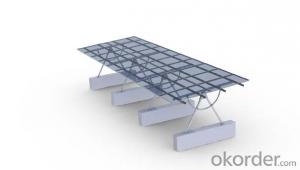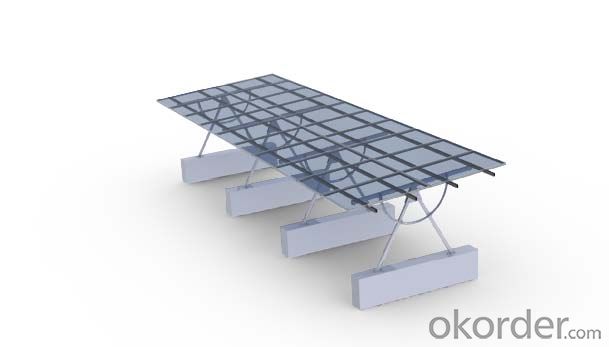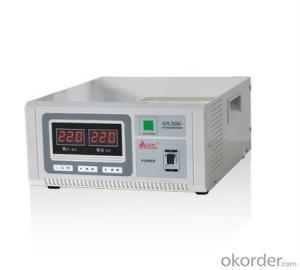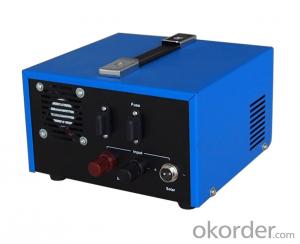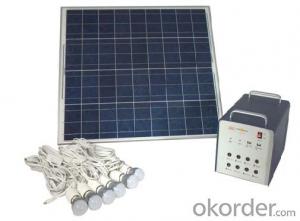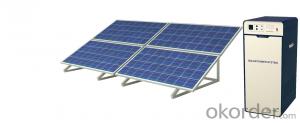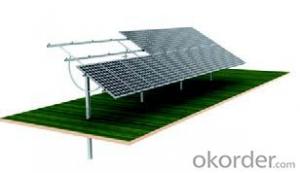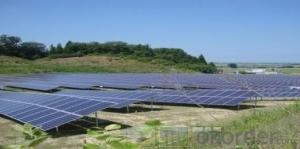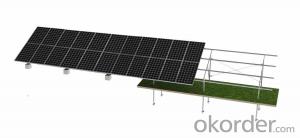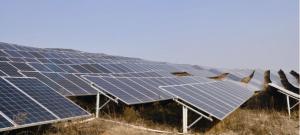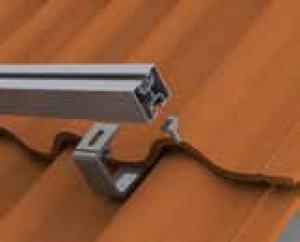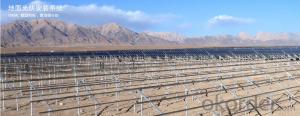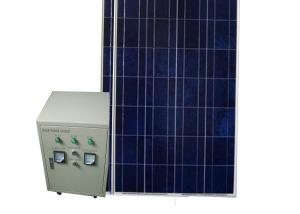Infusion Solar Energy Systems - Double Pile Manual Solar Mounting System
- Loading Port:
- China Main Port
- Payment Terms:
- TT OR LC
- Min Order Qty:
- -
- Supply Capability:
- -
OKorder Service Pledge
OKorder Financial Service
You Might Also Like
Packaging & Delivery
Packaging Detail:Normal package seaworthy
Delivery Detail:15 days
Specifications
Easy installation Competitive price TUV&SGS test report & CSA certification 15-warranty
Specifications
1) Super smooth beautiful appearance,outstanding quality,large supply.
2) Available in customized surface finishes.
3) Well machined,for example,cutting,drilling and milling with excellent tolerance.
4) Meet with customer’s designs and supply you best price.
5)Usages:Supply for solar panel modules.
Technical characteristics
Installation site:
ground,hillside,and grassland
Installation angle
it is based on customers’ requirements
Installation height
it is basedon customers’ requirements
Solar panel type; with or without frame
Components arrangement :horizontal or vertical
Support track
aluminum alloy extrusion
Quality warranty
15 years
Advantages
1)Quick installation: with high degree of pre-installed rate, the system could be easily installed by using galvanized carbon steel rails for PV Stent, and specially designed connection parts of the PV bracket, which could reduce installation time and cost greatly.
2)Offer unmatched durability: with all structural components comprised of high class stainless steel and anodized aluminum alloy, it is designed for 25 years service life and backed by 15 years warranty.
3)Stand up to extreme weather: The SuninTek solar mount is designed to stand up to the extreme weather complied with the AS/NZ 1170 and other international structure load standard by the skilled engineer. The main support components also have been tested to guarantee its structure and load-carrying capacity.
4)Provide broad installation flexibility: These systems accommodate most commercially available framed solar panels , and they can scale easily from small to large, multi-megawatt installations.
5)Diversified Application: The PV mounting system produced can be adopted by various types of PV cells panels which you can find in the market. It can serve for both mini solar power system and huge plant with megawatt capability.
Main features
1. Installation cost savings.
2. Save installation time.
3. Increase the mechanical strength of solar energy mounting to ensure that wind requirements.
4. The outdoor for installation of solar energy.
5. Length can be customized according to customers.
6. Service life of up to 25 years.
7. Products through the international certification.
8. Stent material composition of the galvanized steel and aluminum.
9. 15 years system and structural guarantee.
10.Flexible post spacing withstands different wind & snow loads.
11. High quality material in Aluminium 6005-T5 and SUS 304.
12.Screws and nuts go with every components needed.
13.Mechanical calculation and reliability tested to ensure highest product quality.
- Q: How does the tilt angle of solar panels affect their performance?
- The tilt angle of solar panels greatly affects their performance. The optimal tilt angle allows the panels to capture the maximum amount of sunlight throughout the day, maximizing their energy production. If the tilt angle is too low, the panels may not receive enough sunlight, leading to lower efficiency. Similarly, if the tilt angle is too high, the panels may receive excessive sunlight in certain hours, causing the energy production to decrease. Therefore, finding the right tilt angle is crucial for maximizing the performance and energy output of solar panels.
- Q: Can solar energy systems be used for powering water pumping systems?
- Yes, solar energy systems can be used to power water pumping systems. Solar-powered water pumping systems utilize photovoltaic panels to convert sunlight into electricity, which can then be used to power water pumps. These systems are cost-effective, environmentally friendly, and have proven to be reliable in remote areas where grid electricity is not available.
- Q: Can solar energy systems be used in powering community centers or social organizations?
- Yes, solar energy systems can certainly be used to power community centers or social organizations. Solar panels can be installed on the rooftops of these buildings to harness sunlight and convert it into electricity. This renewable energy source can help reduce electricity costs and dependence on traditional energy sources, making it an environmentally friendly and sustainable option for powering community centers and social organizations. Additionally, solar energy systems can also contribute to raising awareness about renewable energy and inspire others in the community to adopt clean energy practices.
- Q: How do solar energy systems impact energy reliability?
- Solar energy systems can greatly enhance energy reliability by diversifying the energy mix. By harnessing the power of the sun, solar energy systems offer a clean and renewable source of electricity, reducing dependence on traditional fossil fuels. This diversification helps to mitigate the risks associated with potential energy supply disruptions, enhancing overall energy reliability for communities and reducing the impact of power outages.
- Q: Can solar energy systems be used in areas with limited access to solar energy maintenance services?
- Yes, solar energy systems can be used in areas with limited access to solar energy maintenance services. These systems are designed to be self-sufficient and require minimal maintenance. Additionally, advancements in technology have made solar panels more durable and efficient, reducing the need for frequent maintenance. However, it is still important to periodically inspect and clean the panels to ensure optimal performance.
- Q: Can solar energy systems be used for space heating?
- Yes, solar energy systems can be used for space heating. Solar thermal systems can capture the sun's energy and convert it into heat, which can then be used to warm indoor spaces. This can be achieved through radiant heating systems, solar air heating systems, or solar water heating systems.
- Q: Can a solar energy system be installed in an area with high pollution levels?
- Yes, a solar energy system can be installed in an area with high pollution levels. While pollution can potentially reduce the efficiency of solar panels, it does not completely prevent their installation or operation. Solar panels are designed to withstand various environmental conditions, including air pollution. Although pollution may reduce the amount of sunlight reaching the panels, advancements in solar technology have made them more resilient and able to perform even in less than ideal conditions. Furthermore, the installation of solar energy systems in polluted areas can help mitigate the environmental impact of pollution by providing a clean and renewable source of energy.
- Q: What is the role of monitoring systems in a solar energy system?
- The role of monitoring systems in a solar energy system is to collect and analyze data on the performance of the system. This includes monitoring the amount of energy generated, the efficiency of the panels, and any potential issues or malfunctions. Monitoring systems provide real-time insights and alerts, allowing for timely maintenance and troubleshooting, optimizing energy production, and ensuring the overall reliability and longevity of the solar energy system.
- Q: Can solar energy systems be used in powering car charging stations?
- Car charging stations can definitely be powered by solar energy systems. Actually, many car charging stations worldwide already rely on solar energy. Solar panels can be placed on the roof or in close proximity to the charging station, capturing sunlight and converting it into electricity. This renewable energy can then be used to charge electric vehicles (EVs) without depending on the traditional power grid. Solar-powered car charging stations have several advantages. Firstly, they provide a sustainable and clean energy source, reducing carbon emissions and the overall environmental impact of EVs. Secondly, they can be installed in remote or off-grid areas where connecting to the electrical grid may be difficult or costly. This makes solar-powered charging stations especially beneficial for rural regions or highways lacking easy access to electricity. Additionally, solar energy systems can incorporate battery storage, enabling excess energy generated during the day to be stored and utilized during the night or periods of high demand. This guarantees a continuous and reliable power source for car charging stations, even in the absence of sunlight. Although the initial installation cost of solar energy systems may be higher when compared to traditional power sources, their long-term operating and maintenance costs are generally lower. Moreover, there are various government incentives and rebates available to promote the use of renewable energy, which can help offset these initial expenses. All in all, solar energy systems offer a viable and sustainable solution for powering car charging stations, providing environmental benefits, energy independence, and long-term cost savings.
- Q: What is a photovoltaic system?
- A photovoltaic system, also known as a solar PV system, is a technology that converts sunlight into electricity. It consists of solar panels that capture the energy from the sun and convert it into direct current (DC) electricity. This DC electricity is then transformed into alternating current (AC) through an inverter, making it suitable for use in homes, businesses, and industries. The core component of a photovoltaic system is the solar panel, which is made up of multiple interconnected solar cells. These cells are typically made from semiconductor materials, such as silicon, that generate an electric current when exposed to sunlight. The energy produced by the solar cells is directly proportional to the intensity of sunlight, so the system is most effective in areas with abundant sunshine. Aside from the solar panels, a photovoltaic system includes other essential components. These include mounting structures to secure the panels in place, a solar charge controller to regulate the flow of electricity, batteries for energy storage, and an inverter to convert DC electricity into AC electricity. The system may also incorporate a meter to measure the amount of electricity generated and consumed. Photovoltaic systems have numerous advantages. They provide a clean and renewable source of energy, reducing reliance on fossil fuels and mitigating environmental impact. They also offer long-term cost savings as they generate electricity without ongoing fuel costs. Additionally, photovoltaic systems can be scalable, meaning they can be installed on a small scale for residential use or on a larger scale for commercial or utility-scale applications. Overall, photovoltaic systems have become increasingly popular as a sustainable and efficient means of generating electricity. Their widespread adoption has contributed to the transition towards a greener and more environmentally friendly energy landscape.
Send your message to us
Infusion Solar Energy Systems - Double Pile Manual Solar Mounting System
- Loading Port:
- China Main Port
- Payment Terms:
- TT OR LC
- Min Order Qty:
- -
- Supply Capability:
- -
OKorder Service Pledge
OKorder Financial Service
Similar products
Hot products
Hot Searches
Related keywords
